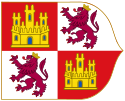King of Castile and León
| Crown of Castile | ||||||||||||||
| Latin: Corona Castellae Castilian: Corona de Castilla |
||||||||||||||
|
||||||||||||||
|
The Crown of Castile in the early 16th century
|
||||||||||||||
| Capital | Burgos, Toledo, Madrid[a] | |||||||||||||
| Languages |
Official languages: Old Spanish (Castilian), Latin Unofficial languages: Basque, Galician, Astur-Leonese, Mozarabic, Andalusian Arabic, Judaeo-Spanish, Guanche |
|||||||||||||
| Religion |
Official religion: Roman Catholic Minority religions: Sunni Islam, Sephardic Judaism |
|||||||||||||
| Government | Monarchy subject to fueros | |||||||||||||
| Monarch | ||||||||||||||
| • | 1230–1252 | Ferdinand III (first) | ||||||||||||
| • | 1474–1504 1479–1516 |
Isabella I and Ferdinand V | ||||||||||||
| Legislature | Cortes of Castile | |||||||||||||
| Historical era | Middle Ages | |||||||||||||
| • | Union of Castile & León | 23 September 1230 | ||||||||||||
| • | Union of Ferdinand II and Isabella I | 19 October 1469 | ||||||||||||
| • | Conquest of Granada | 2 January 1492 | ||||||||||||
| • | Annexation of Navarre | 1512 | ||||||||||||
| • | Nueva Planta decrees | 1715 | ||||||||||||
| • | Ascension of Charles I | 23 January 1715 | ||||||||||||
| Area | ||||||||||||||
| • | 1516 | 380,000 km2 (150,000 sq mi) | ||||||||||||
| Population | ||||||||||||||
| • | 1516 est. | 4,500,000 | ||||||||||||
| Density | 12/km2 (31/sq mi) | |||||||||||||
| Currency |
Spanish real, Spanish maravedí |
|||||||||||||
|
||||||||||||||
| Today part of |
|
|||||||||||||
| a. ^ Itinerant until Philip II fixed it to Madrid. | ||||||||||||||
The Crown of Castile was a medieval state in the Iberian Peninsula that formed in 1230 as a result of the third and definitive union of the crowns and, some decades later, the parliaments of the kingdoms of Castile and León upon the accession of the then Castilian king, Ferdinand III, to the vacant Leonese throne. It continued to exist as a separate entity after the personal union in 1469 of the crowns of Castile and Aragon with the marriage of the Catholic Monarchs up to the promulgation of the Nueva Planta decrees by Philip V in 1715.
The Indies, Islands and Mainland of the Ocean Sea were also a part of the Crown of Castile when transformed from lordships to kingdoms of the heirs of Castile in 1506, with the Treaty of Villafáfila, and upon the death of Ferdinand the Catholic.
The title of "King of Castile" remained in use by the Habsburg rulers during the 16th and 17th centuries. Charles I was King of Aragon, Majorca, Valencia, and Sicily, and Count of Barcelona, Roussillon and Cerdagne, as well as King of Castile and León, 1516–1556.
In the early 18th century, Philip of Bourbon won the War of the Spanish Succession and imposed unification policies over the Crown of Aragon, supporters of their enemies. This unified the Crown of Aragon and the Crown of Castile into the kingdom of Spain. Even though the Nueva Planta decrees did not formally abolish the Crown of Castile, the country of (Castile and Aragon) was called "Spain" by both contemporaries and historians.
"King of Castile" also remains part of the full title of Felipe VI of Spain, the current King of Spain according to the Spanish constitution of 1978, in the sense of titles, not of states.
...
Wikipedia



